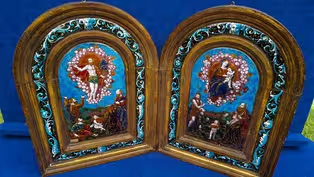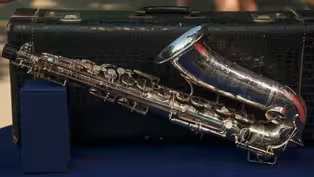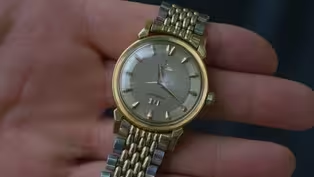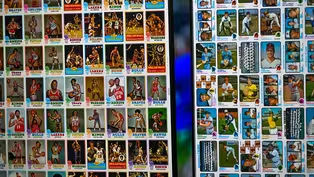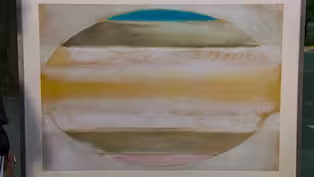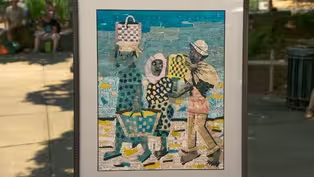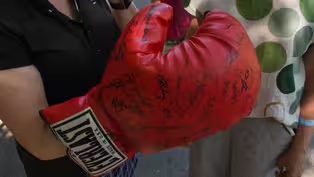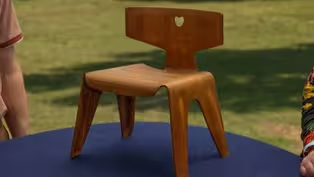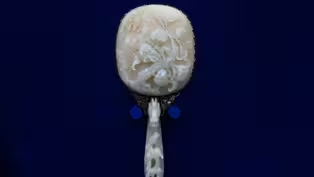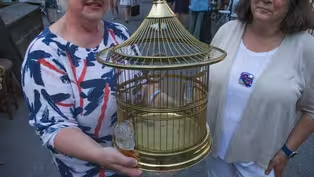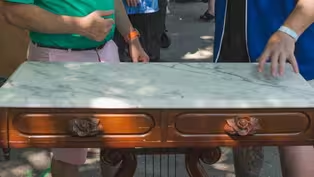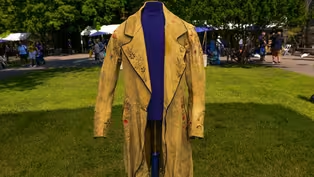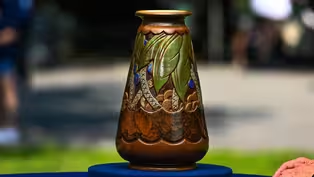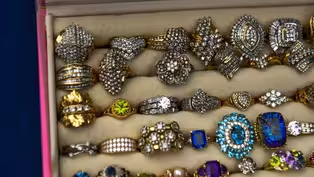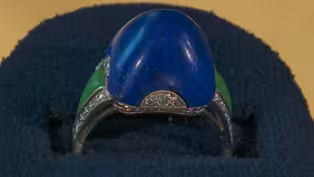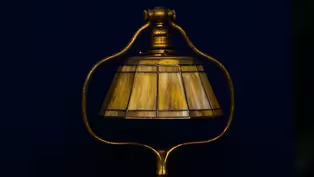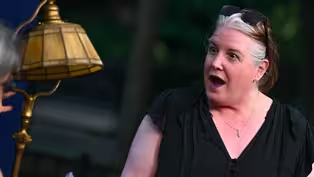
Maryland Zoo, Hour 2
Season 29 Episode 14 | 52m 32sVideo has Closed Captions
ROADSHOW finds rare treasures at Maryland Zoo including one worth $180,000!
ROADSHOW finds rare treasures at Maryland Zoo including 1973 Topps uncut card sheets, a ring collection, ca. 1970 and a 1967 Ram Kumar oil painting. Can you guess the top $180,000 treasure?
Problems playing video? | Closed Captioning Feedback
Problems playing video? | Closed Captioning Feedback
Funding for ANTIQUES ROADSHOW is provided by Ancestry and American Cruise Lines. Additional funding is provided by public television viewers.

Maryland Zoo, Hour 2
Season 29 Episode 14 | 52m 32sVideo has Closed Captions
ROADSHOW finds rare treasures at Maryland Zoo including 1973 Topps uncut card sheets, a ring collection, ca. 1970 and a 1967 Ram Kumar oil painting. Can you guess the top $180,000 treasure?
Problems playing video? | Closed Captioning Feedback
How to Watch Antiques Roadshow
Antiques Roadshow is available to stream on pbs.org and the free PBS App, available on iPhone, Apple TV, Android TV, Android smartphones, Amazon Fire TV, Amazon Fire Tablet, Roku, Samsung Smart TV, and Vizio.
Buy Now
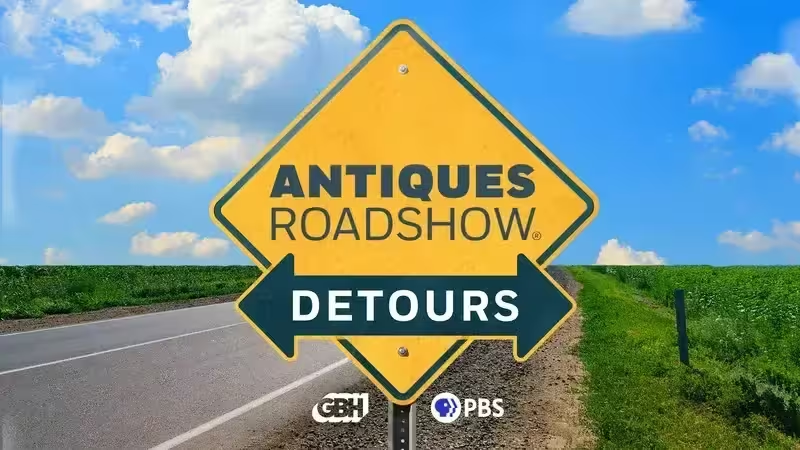
ANTIQUES ROADSHOW DETOURS
Ever wondered what happens to the treasures featured on America’s beloved ANTIQUES ROADSHOW after the cameras leave town? Host Adam Monahan tracks down the juicy afterlives of your favorite finds from PBS’s hit series.Providing Support for PBS.org
Learn Moreabout PBS online sponsorship♪ ♪ (flamingo honks) CORAL PEÑA: "Antiques Roadshow" fans are flocking to the Maryland Zoo.
I can't believe you hid it from your mother and father.
They were really shocked and surprised.
I was so excited, I got chills.
(laughing): Really?
Oh, my goodness.
♪ ♪ PEÑA: The Maryland Zoo is in the heart of Baltimore's Druid Hill Park.
But you'd hardly know we are in a big city when you come upon a habitat simulating a fishing village off the coast of South Africa.
There you'll find some amazing feathered friends-- penguins.
This flightless seabird encounter, built in 2014, is one of the most popular with zoo visitors.
Let's make like a penguin and dive into the treasures.
(cheers) GUEST: I got it off an auction site.
It's the pen used by President, uh, Lyndon B. Johnson to sign into legislation the Public Broadcasting Act of 1967.
APPRAISER: The Public Broadcasting Act, 1967, which established PBS.
"Antiques Roadshow."
"Antiques Roadshow," you see... "Sesame Street."
It's... it's everything.
Mm.
This is what it's all about, and here it is.
When he would sign these acts, he would use several pens.
At auction, I would estimate something like this at about $1,000.
Oh, great.
Thank you.
Yeah.
Very cool, a good little PBS piece of history.
Thank you.
Yes.
GUEST: This is my grandmother's ring.
And she gave it to me in her will when she passed.
And I don't know anything about it other than it's got a really big blue stone that I think is a lapis lazuli.
So I wore it on my wedding day as my something blue.
She was born around 1919, I think, and she worked on the New York Stock Exchange in the 1940s.
And her mother-in-law was someone who worked with diamonds in New York City.
Uh, so my great-grandmother might have had this ring and given it to my grandmother.
It's an Art Deco ring and it's going to be made, I'm thinking around 1925.
Inside the shank-- it's this platinum shank-- it's a very obliterated mark.
And I said, "What is that saying?"
So I took the ten-power loupe and I looked and I looked and it says "Y and Co." Tiff... Tiffany and Company!
Company, you got it, yep, yep.
Oh!
It's Tiffany and Company.
Oh, my goodness!
I know, I know, I was so excited I got chills.
So-- I knew that it had a little bit of writing... Yeah.
...but I could never read it.
I didn't know what it said.
It's-it's there.
It's-it's slightly obliterated, so it's going to be hard for me to show it, but that's, yeah.
(laughs) Wow!
So it would be Tiffany & Co. New York.
Intrinsically, we have not really valuable things.
We have a lapis lazuli, as you know, and that's a sugarloaf cabochon.
Sugarloaf cabochon is a really high cabochon that was really popular in the Art Deco period in the 1920s.
Yeah.
And on the side is chrysoprase, which is not jade.
Oh, okay.
So, chrysoprase was also used in Art Deco jewelry, and it was used, really, just as accent stones.
It's also set with some tiny rose cut diamonds.
Do you have any idea on the value?
I thought it was platinum.
Yeah.
And I thought the diamonds might be real, so I thought maybe a few thousand, but I don't... Yeah, well, it's well worth that.
Okay.
Um, I would say $5,000 to $7,000 auction estimate.
Wow, that's amazing!
So for insurance it would be right around $8,000.
(exhales) Wow.
GUEST: I've got this collage painting, it's an estate sale find.
It's the rare piece in my house where both my wife and I a-appreciate it.
It's the thing in the house that everybody likes.
When was this estate sale?
Two, two-and-a-half years ago.
How much did you pay for it at that estate sale?
It was $390 at most.
The artist is Rosemary Karuga-- she was a Kenyan artist.
She was born in 1928.
Mm-hmm.
And she went to school in 1950.
And between 1950 and 1952, was studying in Uganda.
She studied as an artist, but she had to return to Kenya, and for the next 30 years, was teaching art in primary school, but also a housewife.
Even though she was at the forefront of being one of the first female art students at a major art school in Africa.
Gotcha.
She picked up art again after she turned 60.
What she started using was materials from newspapers and glossy foreign magazines.
Artist materials are expensive and she wasn't from a very wealthy background.
She built her composition up almost like a painter would build up, using layers.
What she enjoyed depicting was life, rural Kenya.
She was living outside of Nairobi.
On the lower middle right, It is signed and dated.
Uh, it's dated 1989 and signed, "Karuga."
She started getting a lot of exhibitions.
She flew for the first time on a plane after 60 years old.
Mm-hmm.
She went to, uh, Paris and the U.K., her works were even exhibited at The Studio Museum in Harlem in 1990.
So she found fame later in life.
So you're never too old to start, uh, to start again.
She passed away in 2021, and her work has been selling pretty well.
I would put a conservative auction estimate of $2,000 to $3,000 on it.
Pr-pretty good at $390, so.
I always tell people when I'm out at these estate sales that, like, one of the reasons I'm there is to find my "Antiques Roadshow" piece.
So I more than exceeded its value in that regard.
GUEST: My wife collected canes, and we came from an antique store in, uh, Chicago, Illinois.
I believe it was right around $25 for the cane, mm-hmm.
Can't go bad-- it was a deal, it was on sale.
(chuckling): It was on sale, so we got it.
These are, uh, posters from three of the World Series, two of them, which we won.
The 1983, we won.
The 1966, we won.
The 1979, we played the Pirates and we didn't win.
But tell them how you got 'em-- you stole 'em.
Oh, well no, these two-- we-- my brother and I climbed up on a-a light post and got them because it was showing the way to Memorial Stadium for the World Series.
I was about 11 or 12 years old.
Uh, I was playing out in my parents' front yard and a man just showed up out of nowhere in a pickup truck.
He got out and he asked me if I wanted some baseball cards.
And I said, "Of course."
(chuckles) He had a big stack of-of, uh, these uncut sheets of cards.
And he peeled off, uh, maybe ten or 12 of 'em and handed 'em to me.
I ran into the house and showed them to my mom, and she said, "Where'd you get those?"
And I said, "A guy just gave 'em to me."
And she-- I-- she looked out the kitchen window and I-I heard her say, "Oh, hi, Larry."
And it was a guy that worked with her.
So it wasn't just a stranger driving down the street handing these out, like candy?
No, it wasn't.
He worked with my mom in a small print publication.
It had, like, coupons and local advertisements in it.
This is the 1973 Topps Baseball High Number uncut sheet.
And then closest to you, we have the 1973-'74 Topps basketball uncut sheet of 132 cards.
These cards were printed to be cut into-into individual cards, and then distributed in wax packs with a-- with a stick of bubble gum.
So how this stack of cards that Larry had is really a mystery.
And there's not a whole lot of these uncut sheets that have filtered out over the years because of that.
So first we talk about the 1973 Topps.
Cataloged as the 1973, it's technically the 1973-'74 Topps basketball series.
Your key card on that sheet is the Wilt Chamberlain card.
That same sheet with the same players in the same order, there's only been one to come up for auction.
I see.
That one there would sell at auction for $6,000 to $8,000.
Really?
Okay.
(chuckles) Now let's get to the 1973 Topps baseball.
This is the rare High Number sheet.
This has two of the Mike Schmidt rookie cards, right here.
And right here.
The reason that's so important is because Mike Schmidt is widely considered the best third baseman in the history of baseball.
Mm-hmm.
He had that rare combination of power hitter and exceptional fielder.
This is the High Number sheet.
The Mike Schmidt rookie card is card number 615.
Okay.
There were 660 cards in this set.
They were printed in lower numbers, the Higher Number series.
With the baseball sheet, there's been only two... Two.
...to come up for auction.
I would expect at auction that this one would sell for $10,000 to $15,000.
(chuckling): Really?
Oh, my goodness.
Oh, wow.
The next question people always ask me is how does this translate, this uncut sheet, translate to the prices of the individual cards?
Right.
And that's r-- very controversial topic.
Okay.
Baseball purists don't want to see anything done to this sheet.
There's other people that are tempted to have this taken to a professional and having it cut into individual cards.
Yeah.
The reason for that is an individual Mike Schmidt rookie card, that's a Gem Mint 10 of the Mike Schmidt rookie, which has been five-graded, and the last one sold for $234,000.
(laughs) It's really impossible for me to say what they would grade at here because we have so many factors.
That's quite a debate that's still ongoing.
If the card should be equivalent in value, if they're cut post-factory.
Yeah.
Well, I can tell you what not to do.
(chuckles) When I was a kid, the other sheets, some of them I cut by hand with scissors because I didn't want a big sheet, I wanted the cards.
Uh-huh.
So you hand-cut a couple.
More than one, yeah.
(chuckling): More than one, yeah.
Three, yeah.
(chuckles) PEÑA: At over 15,000 square feet, the Maryland Zoo has the largest outdoor bird space in the country.
JADE BLAUVELT: We have African black-footed penguins.
We have about 108 in this colony.
Our breeding season runs in the winter.
They'll lay their eggs.
Usually, it's two per clutch.
And they'll sit on those eggs for about 36 to 42 days.
And we have about five to ten chicks every year.
We are big on conservation.
One of the major things that are hindering the population in the wild is overfishing.
PEÑA: While the zoo supports these amazing creatures here, it also works with the South African Foundation for the Conservation of Coastal Birds to help them rescue, rehabilitate, and release seabirds in southern Africa.
GUEST: The coat was in my father's possession.
And he passed away a few years ago.
So I inherited it.
And I have not actually ever taken it out of the box before.
What do you-- I've looked at it and seen how beautiful it was and didn't want to hurt it or disturb it.
So it's been in a box.
This is from Canada.
And the folks who made this are called the Red River Cree, the Métis Cree.
This was tailored by a Indigenous woman, a First Nation woman of Canada, but in a western style.
It's in the style of a frock coat.
In, uh, the 1600s, Canada was called Rupert's Land, and it was being settled and exploited for beaver pelts, the beaver trade.
The Hudson's Bay Company was extremely active in Canada.
They ruled Canada in a certain fashion.
Many of the Hudson's Bay factors were Scottish.
Thomas Douglas in 1811, founded a colony, and it became known as the Red River Colony.
So we have two cultures here.
We have frontiersmen harvesting beaver pelts and sending them back to Europe.
And we had, uh, the Native Cree ladies who were living in the area, and they intermarried with these men, and they became called Métis Cree.
So this is made by a First Nation woman of Cree heritage for probably her husband, who was perhaps a factor in the Hudson's Bay Company, or at the very least, he was working in the fur trade, and he was someone of some significance because it's a pretty fancy coat.
Your average individual would not have had a coat of such splendor.
I would say that this is made perhaps somewhere between 1830 and 1850.
The coat is made out of deer hide.
It's Native-tanned.
The ornamentation is porcupine quill.
The ladies would harvest quills.
They'd flatten them with their teeth.
They dip them in different pigments to dye them, and then they would embroider this quill work in traditional patterns.
So you have floral elements and then stars, celestial orbs, sun devices, moon devices-- extremely important to Native people.
They would derive power from these celestial entities.
These ladies are very attuned to the natural world.
And then the whole device may also be seen as a tree of life.
Ancestors are exceedingly important to Native people.
The glass beads, made in Venice, Italy.
The dye pigments are traded, probably from either France or England.
The blue silk, undoubtedly from France.
It does have some wear-- some of the porcupine quill is missing.
There's a little bit of soiling.
On a retail basis, I would say this is worth $30,000.
(exhales) Wow.
Wow.
It's just fabulous.
It's beautiful, it really is.
I love to see the back-- I hadn't seen it before.
(laughs) Maybe $35,000, $40,000 for insurance purposes.
This is a table that my father got in 1955.
He got it from Liberace.
He worked in Liberace's house in the Hollywood Hills.
It's an American late empire, early Victorian marble-top pier table made of mahogany.
In terms of value, a-as a piece of American furniture, the news isn't great.
So if it were to come to auction, it pains me to say this... Yeah.
...but it's probably only about $150 to $300.
Okay, all right.
Yeah, fair enough.
So, fair enough.
Yeah, all right.
But knowing that it was owned by Liberace, you know...
Okay.
...I'm not a specialist in the field of entertainment, But I have a great colleague... Yeah.
...Laura Woolley.
Let's talk with Laura and see what she has to say about it.
All right.
I don't know anything that, that Andrew just told you.
Empire style, late Victorian.
I don't know anything about that.
Good.
Me-me as well.
(laughs) But what I do know is people love Liberace.
When Liberace died, they needed, like, a football stadium-worth of space to sell everything he owned.
He had a black belt in shopping.
Yeah.
So it's not uncommon for us to see Liberace decorative arts and furniture... Yeah.
...and household goods at auction.
This is a nicer piece-- the lyre form at the bottom... Oh gosh.
...is great because you associate that with music.
Also, you have a photo of him with it.
Absolutely.
So that's a really important thing.
Yeah Most of the stuff that's come up for auction, we don't have a picture of Liberace with it.
Okay.
Yeah.
So the fact that you have that picture means this would probably, at auction, the estimate would be more like $2,000 to $3,000.
Oh, wow, all right.
Oh, that's amazing.
Thank you.
I have better news than my colleague Andrew.
Absolutely!
Oh my gosh.
Wherever he is, forget him.
No, I'm just kidding.
(both laughing) GUEST: This lamp was my paternal grandfather's.
He was an Irish immigrant, and he worked in New York City at, I think, Tiffany Studios.
I inherited this lamp in 2017.
Now it's my treasure.
And do you remember it as a little girl?
Oh, my gosh, yes, yeah.
So here's the funny thing about this lamp.
My dad can be a little naughty sometimes.
So when my mom would go out, he would, my sister and I, "Let's play tag!"
So we would play tag around our homes, and this lamp almost fell over... (laughing): it must have been almost a dozen times, but it's so heavy.
The Tiffany lamps are made with a really good center of gravity, so it takes a lot to-to knock them over.
When did he work at Tiffany Studios?
So that I'm not absolutely sure.
Probably the early 1900s.
The reason I ask is because based on the way this is signed, particularly on the shade, it says "Tiffany Studios, NY."
instead of writing out "New York."
And usually that type of signature would appear on a shade that was made from 1910 on.
I would put a circa date on this between, at the earliest, 1910, and actually it could have ma-- been made as late as 1920.
It's very classical in design, and particularly when you look at the foot, it looks like a stylized Greek key design.
At one point, I thought maybe it was even like an Egyptian influence.
Oh!
Which, in the 1920s, the Egyptian craze touched everything from art to dancing to theater.
Ordinarily, this kind of shade would come with another type of glass, which was called Favrile Fabrique glass.
And that was glass that resembled drapery.
What makes this different is they chose not to use that particular type of glass and-and instead used a standard leaded glass.
Which leads me to believe that it could have been more on the later side.
It's possible that they might have run out of the Favrile glass.
(laughs) And they said, "Well, let's make it this way."
And-and it came out beautifully, it's-it's really a beautiful lamp-- this is the first time I've seen this particular base.
Oh.
So it's-it's unusual.
Mm.
It is a harp base, but also you can turn the shade like this to aim the light.
So if you're sitting in a chair reading, you can get the light.
I... never knew that.
Wow.
They thought of everything at Tiffany Studios.
The Tiffany lamps that were being sold were, they were always luxury items and they were expensive.
The average worker couldn't really afford them.
And they would be listed in catalogs.
They came in different finishes.
So you could get a brown.
A brown-green finish on it.
But if you opted to go for a gold finish, then there was an additional 25% on top of the cost of the lamp.
It's bronze, but it's gold-plated.
Bronze.
They only use the finest materials at Tiffany Studios.
Oh, wow.
Oh, that's wonderful.
This has an acid-etched finish.
That's why you see this mottling on the surface.
And the shade could easily have been sold separately.
In a retail venue, this would sell for between $10,000 and $15,000.
That's exciting!
(giggles) That's so cool!
GUEST: This is a devil bank that I found in the Poconos at a local auction that my mom's been taking me to since I was a kid.
There's kind of a back room where they do box lots.
My mom told me, "Hey, look at this one box.
"It's got a bunch of old mugs in it, Mugs that you wouldn't really want."
But I was like, "All right, I'll-I'll bid-bid on it if you tell me to."
We ended up getting the box lot for ten bucks.
And, uh, this bank was in there, so my mom, you know, knew what she was doing.
How old were you when that happened?
Uh, I was probably about 11 or 12.
Do you have any idea what the value is?
I was saying about $300 to $400.
My mom said about $500, so I'll go-go with about $500.
(soft chuckle) Either way, you're well, well beyond the ten dollar purchase price.
Absolutely.
So this is the two-sided devil still bank.
It doesn't have any movement or any motion.
If it had a spring-loaded motion, it would be a mechanical bank.
It is made of cast iron.
It's two halves and they're screwed together here.
And that's actually how you get the money out of the bank once you make the deposit into the top.
They're hand-painted.
And there are a lot of collectors for still banks as well as mechanicals.
They manufactured still banks in different forms: figural, such as this devil, architectural, animals, transportation.
All the figural still banks were designed to inspire kids to want to save money.
This actually was in production around 1910.
Oh, wow.
Uh, I believe the devil was from 1904 to 1912.
Wow.
A.C. Williams is the name of the manufacturer of this bank.
Okay.
Uh, and they're out of Ohio.
I'm happy to report that this is an original example.
Oh, wow.
They did reproduce this.
In grading, the hand-painted still bank such as this, condition is king.
A lot of the high points on his nose, on his cheek, do show some paint wear and paint loss.
But you still have above average paint on this example.
His eyes and his teeth are really nicely painted and decorated.
They're accented well.
This is a very popular bank.
It's a relatively scarce one.
The estimation I would place on this for an auction would be $1,000 to $1,500.
(chuckling): Wow, that's incredible.
That's even more than what I was expecting.
I mean, and like you said, a far cry from ten bucks.
That's incredible, oh, my God.
That's, that's for sure.
That was a good box lot.
Absolutely.
If the paint was a bit stronger, the price would continue to notch up.
Commanding $4,000 or $5,000 for a two-faced devil is not, uh, too far of a fetch.
Wow.
Wow, okay, well, no, I'm, I'm happy with this.
Wow, that's incredible.
(laughs) This is just a photograph I got at auction.
I think this was like 30, 40 bucks.
He's a photographer named Tony Gleaton and it says "Chihuahua, Mexico."
So I think it's of a, a person in Mexico.
I was at an auction with my husband, and the bidding went up, and I bid and it was kind of high bid-- $1,000.
My husband jumped out of the chair and the auctioneer started laughing and he couldn't stop.
That's my story.
GUEST: My husband and I inherited this from his grandmother.
She bought it for her first daughter in the early '50s.
And it was played with and used.
I was told it was an Eames chair.
It is a chair that was designed by Charles and Ray Eames in 1945.
Okay.
For the Evans Products Company out of Venice, California.
The Eames's got started in plywood manufacturing initially because they were contracted by the U.S. government to work with the Evans Plywood Company to create leg splints for the wartime effort.
Wow.
And they created that leg splint around 1942.
They had had some previous experience doing molded plywood designs, but this little chair ends up being the first one that they create with Evans between 1945 and 1947.
Okay.
Now, production got taken over by Herman Miller in the early '50s.
But we believe that there were no more than 5,000 of these little chairs ever produced.
And they were available in a series of colors: red, black, yellow, blue and magenta.
Yours is sort of unfinished, raw birch plywood.
There are one or two people that remember it being red and that it had been stripped.
When you first brought it to the table, that was also my first thought, that it might originally have been a red aniline dye.
That condition issue doesn't affect it tremendously.
Okay.
It's made of two pieces of molded five-ply plywood that is joined on the underside-- the back joins the seat with these three rivets in a triangular position.
And that's how we know it's one of the early examples of this chair.
Okay.
The Eameses were really interested in traditional folk art and symbolism.
And so they an-- they-they put that heart there, kind of as a nod to the sweetness of childhood.
But it also has a practical role.
It's meant so that little fingers can lift the chair... Oh... ...and move it around.
Collectors of Eames know this chair as the Child's Nested Chair, also known as the Heart Chair.
And the idea was that children could stack these, and as a result of them being child's pieces... Mm-hmm.
...not a lot of them survive.
In the past 20 years, I think we've seen maybe 30 come up to auction.
Okay.
So they really are an absolute prize for Eames collectors.
So in today's market, at auction, we would estimate this chair between $3,000 and $5,000.
Wow, okay.
(laughs) That's great news, thank you.
PEÑA: The Maryland building was built for the World's Fair in Philadelphia in 1876, then dismantled, moved and reassembled here the following year.
But the oldest building on zoo grounds is the Mansion House, built in 1801.
IAN SHELLEY: The oldest structure in Druid Hill Park is the Rogers Mansion House.
Over the years, it's gone through many uses, it has been a restaurant.
It also, for many years, served as an animal house.
It provided a habitat for the zoo's bird collection as well as for the zoo's primates.
It fell into disrepair for many years, but it underwent a great restoration, and it now serves as the main administrative hub for the Maryland Zoo in Baltimore.
GUEST: My wife's aunt passed away in 2019, and she was a collector of all kinds of art, but particularly African American artists.
And my wife inherited, uh, a number of pieces from her, and that's how we got this.
And do you know the name of the artist?
Yeah, it's Ed Clark.
What did you discover on the back of the piece?
What we found was a handwritten inscription which said was pa-- done in April 1976, Yucatan, Mexico, Merida, Yucatan, Mexico at the Hotel American.
Ed Clark was a very important African American artist.
He reached a level of prominence later in his career.
He was born in 1926 in New Orleans and passed away in 2019.
He began as a figurative painter while studying at the Art Institute in Chicago.
He later moved to Paris and his style changed dramatically.
He synthesized the European and American post-war abstraction to form his own style.
He returned to the U.S., emerged on the New York art scene and, really, produced for 70 years, where his work began being shown and collected.
Institutions such as MoMA, the Metropolitan Museum of Art.
Recently, the Smithsonian Museum of African American History and Culture have acquired his work.
And also in the collection of the Studio Museum of Harlem.
Clark produced work on canvas and also on paper.
This is a work on paper, it's pigment on paper.
Something that is indicative of his work are the bands of color, that is signature to his style.
It's reflected in the works on canvas and paper.
In recent years, his work has become highly sought after.
So I would give a conservative estimate of between $50,000 and $65,000 in a gallery.
Wow, thank you.
You have a really beautiful piece here by Clark, and it's quite a gem.
Yes, we like it very much.
GUEST: It is what's known as a diptych.
On the back it says that it was done very early, I believe in the 1500s by one of the Limoges artists.
It has the initials "J.P." but more than that, I don't really know very much about it.
And how did it come into your possession?
It came into my possession through my husband, who is an art and antique dealer.
Uh-huh.
It was said that it came from one of the Heinz estates.
My husband and I had a very unusual relationship, and he got sick and we got married, like, two weeks before he passed away.
How much did your husband pay for them?
$10,000.
And how long ago was that?
About three years ago.
So you did mention that it's Limoges.
And Limoges is a place in France.
It's the center of Limoges enamel work, which this is a very good example.
It's really a medieval art form, and it's one of the areas of medieval craft that still exists in quite large numbers today.
In the 1100s is when it started, and it was created all the way through and reached a high point during the 1500s in the Renaissance.
So you have two panels here within this, sort of, arched frame which closes.
And on the left hand side we have the "Ascension of Christ."
And on the opposing panel, Mary.
Here we have "I-N-R-I," which we've seen on many crucifixes all over the world.
Jesus of Nazareth, King of the Jews, in Latin.
And on this side we have "Meta dei," and that means "Mother of God."
Did you mention also that it had initials on it?
"J.P." It's Jean Pénicaud.
And there were three Jean Pénicauds that were working in the 1500s.
Okay.
This is dated to 1557, and so I think it's Jean Pénicaud II.
Okay.
It's set within this wooden frame.
We can see that there's quite a lot of worm damage on the frame here, which makes it look like it's an old frame, but we believe by consensus that these are probably 19th century.
Oh, really?
How interesting.
The plaques themselves, as we said, we do believe, are from 1557.
These pieces were enormously popular.
There was so much demand.
There was many late 19th century enamels that were made in the 16th century style, which are just completely fake.
Okay.
That said, I do believe that these two central panels are real, but I think that it's been embellished, if you like, with these additions.
There's another aspect to this which I think is quite interesting, and that is this little label here, "3391," that looks very similar to a Goupil label.
And the Goupil Company were an auction company in Paris founded in 1850 by Jean-Baptiste Goupil.
Hmm.
They dealt in these sorts of pieces quite frequently.
So it could be that this came through their auction house in the late 19th century, perhaps around the time that they were inserted into this backing.
The depictions here are absolutely stunning.
The colors are still so vibrant.
These are vitreous enamels so they won't really fade.
There are some cracks here.
Okay.
That will adversely affect the value.
In auction, this pair today should sell for, comfortably, $20,000 to $40,000.
Okay, that's great.
They're wonderful pieces.
Mm-hmm.
That's incredible, thank you.
I think it may be a Sicard pot, but I don't know.
Sicard by the Weller Pottery in Zanesville, Ohio.
Yes.
Weller Sicard's a good guess, but what you have is an even better piece.
This is a piece of Pewabic Pottery... (gasps) Hm.
...from Detroit dating to 1915 to 1920.
To find a piece like this, which is 100% red, is most unusual.
It's about a one in 500 piece of Pewabic.
Wow.
It's a-- yeah, it's a beauty, Oh, I'm so happy.
Really, very special.
So it's easy, auction estimate is between $1,500 and $2,000.
(gasps) But it would bring between, it would actually sell for should be $2,000 to $3,000.
Wow.
It's a nice pot.
Wow.
So, thank you.
Oh, my God.
GUEST: My great-grandfather's uncle was an attorney in Cumberland, Maryland.
APPRAISER: Okay.
And received this letter from somebody who lived in Brookville who may be a distant relative as well.
Okay.
Um, asking for the release of a person who had been recaptured and re-enslaved 26 years after their original release in 1820.
And so the addressee is Thomas Harvey, Esquire, an attorney in Cumberland, Maryland, MD.
And you can see the postmark from 1846.
And what he says is his father freed all of the enslaved people...
Right.
...that he "owned" in his will.
And the rule was, men freed at 21.
Mm-hmm.
Women at 18, right?
Right.
But this man has also kept tabs on one particular man-- he says he was sold by his nephew to another man.
To a person in Cumberland.
"I have little doubt "but Samuel Thomas sold him as a slave, but that will have no effect on his right to immediate freedom."
The year this letter is written is 1846.
Mm-hmm.
And this man should have been freed in 1820.
Right.
He knows his date of birth.
June 14, 1799.
He knows his name, Richard.
He knows he's lost an eye, As-- he's injured himself, so yes.
By some unfortunate... And he mentions that this should be kept, kind of, on the down low.
Right.
"Should I be obliged to petition for his freedom, "it may cost his owner all his wages to this time.
"Please make some enquiry "who his master is without letting Dick know of his right for the present."
For the context of what was going on in Maryland at this period, there was the Nat Turner's rebellion in early 1830s in Virginia... Mm-hmm.
...and it made a lot of white, slave-owning people very worried about a slave revolt.
As a result, the Maryland legislature had really cracked down very heavily on the movements of enslaved people.
People that owned property in Baltimore that were free, were not allowed to send their children to school... Oh.
...even though they paid school taxes.
Frederick Douglass himself escaped in 1838-- from Baltimore.
Right.
And the year this letter was written in 1846, there was a man who had established a bunch of underground railroad stops who died in jail in 1846 just for helping.
Wow.
So for this person to put themselves out there and say, "I know that there's this person who's being horribly wronged, "and I want the help of an attorney.
I want to do right by this man," is he's really exposing himself to a lot of risk.
That's interesting.
So he had to have really strong beliefs in a time when a lot of people did not stand up for the moral right.
Mm-hmm.
Another interesting point is Black Americans have a lot of trouble doing genealogy because so much of their history has been completely expunged as though it didn't exist.
We have a location, we have a first name.
We have, uh, the month, the day and the year, 1799, that he was born, and so that might be just the little tidbit of information that a genealogist is looking for or needs...
Right.
...to put together somebody's complete genealogy of somebody living now.
If I was to assign an auction estimate, I would say $2,000 to $3,000 at auction.
Oh, that's fantastic.
That's really cool.
Thank you for that background, too, that's fascinating.
This was a wedding present for my mom.
I'm not sure where she got it, but the wonderful thing about it, it's from Tiffany's and the address is 550 Broadway.
And they were at that location in the 1850s.
So that dates it.
I don't know the maker-- pretty sure it's German.
It's, I believe, all original paint, all original pieces.
I bought it online.
I paid like $2,000.
GUEST: Along with my sister, I inherited this in 2021 from our mother.
She inherited it from a foreign service officer that she worked with.
And this foreign service officer was stationed in a lot of countries in Asia.
This is one in a collection of jade, and I believe marble, pieces.
Mm-hmm.
She was very fond of jade... Mm-hmm.
...this foreign service officer lady.
She liked to collect jade, marble, and all these Asian trinkets.
And my mom loved them, so she displayed them.
And we keep them in a box.
(chuckles) Let me just turn it around and you'll see here as it fits the silver mount nicely chased with bats.
And we have bats surmounting either side here.
And the handle's nicely chased to the underside.
And there's the garment hook.
This would have been tied into a garment.
There are two pieces of jade.
Neither one started life with an intention to become a hand mirror.
Okay.
So the jade is likely 18th century, Chinese, it's a celadon whitish jade, very well carved, great detail.
It depicts peaches, the Chinese auspicious symbol for bounty, life, longevity, abundance, a long extended life.
The lower jade is a garment hook or a belt hook.
That's a stylized dragon.
So it's possible that the hand mirror was comprised in the 1920s, that was Edwardian or early 20th century period of the vanity or the brush set.
Sure.
So that would be consistent with dating this piece.
And it's likely that the fitted box was contemporary to the construction of the hand mirror.
The value in a retail setting, the box and the hand mirror together, would be $10,000.
Oh, wow!
Okay!
Good to know!
(chuckles) It's exciting.
APPRAISER: It's the Omega Seamaster model.
And when you look at it, well, yeah, okay, that's typical of Omega Seamaster.
It is 18 karat solid gold.
Omega, as you know, is a Swiss watchmaking company.
What you don't know, and when I saw it, it threw me back just a couple seconds is on the dial down here we see Roman numerals-- there's "X-V-I."
Okay.
That is for the 16th Olympics, okay?
Now we turn the watch over, and on the back we have the logo.
I've see maybe one show up on "Roadshow" every five to six years.
It's a pretty rare watch.
Yeah, had no idea.
Yeah.
Had no idea.
Pretty scarce.
In today's market, a retail on this is going to bring about $7,000 to $9,000.
Wow.
(chuckling): Wow, wow!
That's much more than we ever thought it would be.
That's amazing.
That's amazing.
It certainly is.
That was a surprise to me.
We almost didn't bring it.
(laughs) That's-- Yeah!
It doesn't look like much, does it?
No.
It doesn't, no.
GUEST: I'm from New York City.
I came down on the bus.
APPRAISER: Just to come to "Antiques Roadshow?"
Just to come to "Antiques Roadshow."
It wasn't easy, but I got here.
I love what you brought us, and how'd you come about it?
I got it as a gift.
One of my neighbors that I befriended, I assisted him going to the store, cooking dinner.
That's how I got it.
When we see something this quality, this kind of combination of colors, this scale, this type of glaze, it looks like the work of two brothers who were potters in a place called Nancy in France called Mougins.
And we'll turn it over.
And sure enough, there it says, "Mougins, Nancy."
Nancy is the town that the Mougins brothers worked in.
Okay.
And they were active from about 1900.
At the time they started, they were making what we call Art Nouveau pottery.
Mm-hmm.
Mm-hmm.
Very colorful organic designs.
Mm-hmm.
But by the time the '20s roll around and into the '30s, their style evolves with modern taste... Mm-hmm.
...into what we call Art Deco design.
Mm-hmm.
Now, this piece is very Art Deco.
I would date it to the later 1920s... Oh, wow.
...and into perhaps.
around 1930, '31, '32.
Wow.
These bold green leaves are not leaves you'd find in Nancy, which is in the Lorraine region of France.
But this was a time in French history when the French really discovered their, kind of, colonial world.
Mm-hmm.
There was a big exhibition in Paris in 1931... Mm-hmm.
Mm-hmm.
...called the Exposition Coloniale.
They brought exotic creatures, animals from Africa, and they brought designs of palm trees and exotic flora into the French taste.
Oh, okay.
So we see a lot of that kind of thing... Oh, wow.
...around the late '20s, into the early '30s.
It's made of pottery, not thrown on a wheel.
It would have been cast, slip cast.
And then it's glazed in a rich coloration.
There's a kind of mottled brown here, matte-ish brown here, slightly metallic, and this slightly metallic green.
It's very, very effective.
Mm-hmm.
These bright blue fruits, just a great example of the Mougins brothers' potting skills.
Mougins brothers.
You've got something special.
Oh, I thought so.
(chuckles) Yeah.
If we put it in an auction, it's going to bring somewhere between, one of my colleagues said between $1,000 and $2,000.
Mm-hmm.
I'm going to say a good estimate, at auction... Mm-hmm.
...would be between $1,200 and $1,600.
So I think that's-- (chuckling): Oh wow.
That's good.
That's-- That's good for a gift, eh?
That's a nice gift you got right there.
That's right.
Now it's worth that, largely because it's perfect.
DANIELLE REGAN: We have three North American river otters here at the Maryland Zoo in Baltimore.
The two you see behind me are Hudson and Nora.
Both came to us from the rescues from the wild.
North American river otters are extremely active animals.
They are found in bodies of fresh water that are not polluted.
In the early 20th century, otters were often trapped for their pelts.
Overtrapping caused their populations to decline.
But since then, fur trapping is not legal, and their numbers are certainly making a comeback and they're doing really well out in the wild.
GUEST: I brought in a box of jewelry from my grandmother that I got when she passed away back in 2020.
We were in the hospital and she called me in and then she gave this to me before she died.
She told me to put it up in somewhere safe.
So I just put it in my closet, and I kind of forgot about it, until I heard I was going on the "Antiques Roadshow" I wanted to bring it.
Is that when you told your parents?
(chuckles) Yes.
(laughs) I can't believe you hid it from your mother and father.
What was their reaction when you...?
They were really shocked and surprised.
What do you know about these rings?
I don't know much, but when I was younger, she used to paint my nails, and we used to play with them a lot.
And I knew she had, like, a big collection of them.
Most of the rings in here are real.
All of these rings in the top rows are real gold and real diamonds.
Now, a few of these big ones, like this... ...and this one and this one, the real big diamonds are not.
They're cubic zirconia.
But all the smaller diamonds in the rings are all diamonds.
The only rings that are not gold and that do not have, uh, genuine stones in them are all the rings right here in this bottom row.
Okay.
But over here you have blue topaz.
You have blue sapphire.
This green one is peridot.
You have a real cultured pearl there.
You have amethyst.
Over here you have more peridot, amethyst, citrine.
You know what this one is, right?
A ruby, maybe?
Right, rubies.
And this one?
Emeralds?
That's right.
You have some rings that are a little larger.
Like, this one's amethyst, this one here is synthetic.
It's a big stone-- this one here is synthetic.
This one here is synthetic.
But the ring is still gold.
Ten karat, 14 karat.
There are some rings here that are manufactured in the United States.
There are rings in there that are manufactured in China.
There's a bunch of them, especially the smaller colored stones, that would have been manufactured in Thailand.
I would say overall, they range anywhere from the mid-1960s through the mid-1980s.
(chuckling): That's old.
(chuckling): That's old!
If I add up what's here, it's $15,000 to $25,000.
That's a lot of money-- your grandmother loved jewelry, no doubt about it.
Mm-hmm, yes, she has a lot.
There's more?
No?
Yes, I have a lot more at home.
(laughing): Is it still being hidden?
(laughing): Yes.
Have your mom and dad seen it yet?
(chuckling): Not yet.
(laughs) My parents got it at some point in the '80s, in Eastern Europe.
They gave it to my wife and me as a wedding present.
It was made in Poland, Warsaw, in 1954.
Its title is, uh, "Whites and Browns," and it's made mainly of natural fibers.
And that's about all I know, other than it hangs on my wall.
I believe it's an Arts and Crafts chair.
Maybe British, maybe Irish.
I bought it in Dublin around 1980.
For me, it was a lot of money.
It was probably about, uh, 100 Irish pounds at the time.
It's super comfortable, it's been in my living room for the last 42 years.
GUEST: I bought this saxophone when I was in high school.
I actually bought it around my tenth grade year.
We were told by the store that it had previously been owned by a jazz musician.
You remember what you paid for it?
I think I paid $1,500.
My mother thinks I paid $2,500.
And the year was?
1990-ish?
What you have is a Selmer saxophone.
Selmer has been, from the beginning, uh, the preeminent brand of saxophones.
All the best professional players have played Selmer horns at one time or another and many of them were Selmer endorsers and played them their whole career.
This horn is considered a large boar horn.
Selmer started building horns in 1922.
This horn is from 1929.
In 1928 they made their first major improvement... Mm.
...which was making them large bore.
And this is the first of the large bores.
They made them for four years.
The big bore gave it much more power and much more flexibility in the tone.
The engraving goes below where the bell meets the end bow.
And that indicates that it was made and engraved in Paris and sold in Europe.
Oh!
Oh!
They made very poor cases for their European horns.
(laughs) They were actually like pressed cardboard.
Mm.
And this is a professional American-made case.
So this is a case that somebody replaced.
These are-are really special horns.
Uh, and this is in special condition.
You don't hardly ever see them without wear on 'em like this.
It's heavy silver plate over brass.
And on all the places where your hands touch it, it usually wears through.
Mm.
And these horns are usually spotted or sometimes even without silver plate left at all on them.
On a retail sales level, I would estimate that this horn would sell for between $3,500 and $4,000 today.
Really?
That's great!
Yeah.
And it has a nice overhaul on it and good pads.
Yeah.
It looks playable as it is.
That's great.
It's been sitting under the bed for 30 years.
(chuckles) In the '90s, I was the chairperson for the International Boxing Hall of Fame banquet.
And I met lots and lots of boxers and trainers and, uh, promoters and writers.
Well, it's like 50 signatures on here.
Yeah.
And you have Hall of Famers here.
You've got Floyd Patterson.
Yes.
You've got Joe Frazier-- "Smokin Joe."
Smokin', yeah.
And you've got Ken Norton.
Yeah.
So you have some of the great boxers of the '60s right up to the present.
Yeah, yeah.
Right?
So when we look at autographs, we're looking at the historical importance, but we're also looking at the quantity because you've got a good snapshot here.
Yeah.
And also it's great to have them on this giant glove.
Yeah.
Yeah.
I didn't even know they made these giant gloves.
Yeah.
So if I was gonna put an auction estimate on it... Sure.
...as a group on this, I would probably put somewhere between $800 and $1,200.
Wow.
Wow.
Very exciting.
So what would you say to that?
It's a knockout.
There you go!
There you go.
I knew you'd come out punching.
(chuckles) Yeah!
Yep, yep, yep.
GUEST: My parents lived in India in the '60s.
My dad had gotten a Fulbright scholarship and so they traveled there.
The second time they went to-- for him to do research, between '68 and '70s, they had a friend who said, "Oh, I know this artist, Ram Kumar."
And so they got introduced to him in a park in New Delhi.
And he invited them back to his studio and they bought this beautiful painting.
And it's been in my family since I was a kid.
I always just loved it, it would hang on our living room wall.
Do you know what your parents paid for it?
I asked my mom and she really didn't remember.
He grew up in the north of India in Simla.
Now it's Shimla.
It's right near Nepal, so it's very hilly and mountainous and beautiful.
And as a kid he loved the landscape.
And that was sort of a place he liked to escape to, to just sort of enjoy.
His father worked for the British government, and he was sort of thinking of going in the same direction.
And he was studying at St. Stephen's College, working on an M.A.
in economics.
And he'd always been interested in writing, but some friends sort of got him interested in art.
Hmm.
In 1949, he decided to go to Paris.
He got permission from his parents to get a one-way ticket.
Ah.
Where he studied with André Lhote, uh, Fernand Léger.
And he just, he soaked in the culture.
Hmm.
He loved the culture, so he was seeing contemporary exhibitions, he was seeing the works of Picasso and Modigliani, but he was also seeing the Old Masters.
Hmm.
And then he came back and settled primarily in New Delhi.
Hmm.
He certainly brought what he learned with him.
But in this particular case, he also wanted to make sure his style stayed Indian.
Hmm.
He was part of the first generation of post-colonial Indian painters.
Hmm.
And that was important to him.
It's an oil on canvas.
It's signed and it's also dated 1967, and this is really when he started to go more abstract.
He found people were distracted by his figures.
When he put figures in his paintings, people just focused on the figures... Hmm.
...and they didn't look at anything else going o-on around them.
Mm-hmm.
And so he started removing the figures.
This is right at the moment that he's really just mastering abstraction.
And so it's really from his mature style.
It's from a great date.
It's really in pretty terrific condition.
So realistically, for an insurance value... Mm-hmm.
...I would insure it at about $180,000.
Wow.
Okay, good to know.
(chuckling): Yeah, I will definitely, uh, keep taking good care of it.
It's very, really, a keepsake of my family, so I look forward to being able to keep it on my wall.
I would probably frame it.
Okay.
A frame not just beautifies, but also protects.
Okay.
PEÑA: You're enjoying "Antiques Roadshow" PEÑA: And now it's time for the "Roadshow" Feedback Booth.
We drove six hours from Buffalo, New York, and turns out my Kuna molas is not worth much moolah.
And my Stradivarius is not a 'varius!
(laughs) But we both worked on our tans.
We got a great tan today.
Thank you.
We had a great time at the "Antiques Roadshow."
We brought this Asian piece of artwork that we thought was, you know, pretty authentic, but we found out it's actually a print of an actual painting.
So we learned a lot and had a great time, thank you.
And they're not playing lacrosse.
They're playing some polo type game.
Yeah.
We brought this jurors reel-- wheel from 1800s.
And the verdict is... guilty!
We're winners.
(both laughing) I brought my gorgeous cat painting that was picked from the trash many, many years ago from my father, and I found out today it's worth $800 or $900.
And I am over the moon thrilled.
We've been toiling around for years.
Years.
In the Minors.
We finally made it to the show.
The big show.
The "Antiques Roadshow."
Although everybody liked it, my glasses and my pins, it wasn't appraised.
But on the other hand, my handbag was appraised for $500, yay!
(chuckles) We've been watching "Antiques Roadshow" since she was a little baby, so we had a lot of fun.
Thank you, "Antiques Roadshow."
Bye!
PEÑA: Thanks for watching.
See you next time on "Antiques Roadshow."
Appraisal: 1557 Jean Pénicaud II Limoges Enamel Panels
Video has Closed Captions
Clip: S29 Ep14 | 3m 14s | Appraisal: 1557 Jean Pénicaud II Limoges Enamel Panels (3m 14s)
Appraisal: 1846 Letter Demanding Release of Enslaved Person
Video has Closed Captions
Clip: S29 Ep14 | 3m 35s | Appraisal: 1846 Letter Demanding Release of Enslaved Person (3m 35s)
Appraisal: 1929 Selmer Alto Saxophone & Case
Video has Closed Captions
Clip: S29 Ep14 | 2m 3s | Appraisal: 1929 Selmer Alto Saxophone & Case (2m 3s)
Appraisal: 1956 Omega Seamaster XVI Watch for Olympics
Video has Closed Captions
Clip: S29 Ep14 | 1m 10s | Appraisal: 1956 Omega Seamaster XVI Watch for Olympics (1m 10s)
Appraisal: 1967 Ram Kumar Oil Painting
Video has Closed Captions
Clip: S29 Ep14 | 2m 38s | Appraisal: 1967 Ram Kumar Oil Painting (2m 38s)
Appraisal: 1973 Topps Uncut Card Sheets
Video has Closed Captions
Clip: S29 Ep14 | 3m 36s | Appraisal: 1973 Topps Uncut Card Sheets (3m 36s)
Appraisal: 1976 Ed Clark Abstract Expressionist Artwork
Video has Closed Captions
Clip: S29 Ep14 | 2m 11s | Appraisal: 1976 Ed Clark Abstract Expressionist Artwork (2m 11s)
Appraisal: 1989 Rosemary Karuga Magazine Collage
Video has Closed Captions
Clip: S29 Ep14 | 1m 58s | Appraisal: 1989 Rosemary Karuga Magazine Collage (1m 58s)
Appraisal: Autographed Boxing Glove, ca. 1990
Video has Closed Captions
Clip: S29 Ep14 | 1m 4s | Appraisal: Autographed Boxing Glove, ca. 1990 (1m 4s)
Appraisal: Cast Iron Two-faced Devil Bank, ca. 1910
Video has Closed Captions
Clip: S29 Ep14 | 2m 26s | Appraisal: Cast Iron Two-faced Devil Bank, ca. 1910 (2m 26s)
Appraisal: Charles & Ray Eames Child's Nested Chair, ca. 1945
Video has Closed Captions
Clip: S29 Ep14 | 2m 51s | Appraisal: Charles & Ray Eames Child's Nested Chair, ca. 1945 (2m 51s)
Appraisal: Chinese Jade-mounted Mirror with Fitted Box, ca. 1920
Video has Closed Captions
Clip: S29 Ep14 | 2m 1s | Appraisal: Chinese Jade-mounted Mirror with Fitted Box, ca. 1920 (2m 1s)
Appraisal: Hendryx Co. Brass Bird Cages, ca. 1930
Video has Closed Captions
Clip: S29 Ep14 | 1m 3s | Appraisal: Hendryx Co. Brass Bird Cages, ca. 1930 (1m 3s)
Appraisal: Liberace's American Marble-top Pier Table, ca. 1860
Video has Closed Captions
Clip: S29 Ep14 | 1m 35s | Appraisal: Liberace's American Marble-top Pier Table, ca. 1860 (1m 35s)
Appraisal: Métis Cree Frock Coat, ca. 1840
Video has Closed Captions
Clip: S29 Ep14 | 2m 58s | Appraisal: Métis Cree Frock Coat, ca. 1840 (2m 58s)
Appraisal: Mougin Frères Pottery Vase, ca. 1930
Video has Closed Captions
Clip: S29 Ep14 | 2m 53s | Appraisal: Mougin Frères Pottery Vase, ca. 1930 (2m 53s)
Appraisal: Ring Collection, ca. 1970
Video has Closed Captions
Clip: S29 Ep14 | 2m 56s | Appraisal: Ring Collection, ca. 1970 (2m 56s)
Appraisal: Tiffany & Co. Art Deco Ring, ca. 1925
Video has Closed Captions
Clip: S29 Ep14 | 2m 6s | Appraisal: Tiffany & Co. Art Deco Ring, ca. 1925 (2m 6s)
Appraisal: Tiffany Studios Floor Lamp, ca. 1915
Video has Closed Captions
Clip: S29 Ep14 | 3m 24s | Appraisal: Tiffany Studios Floor Lamp, ca. 1915 (3m 24s)
Video has Closed Captions
Preview: S29 Ep14 | 30s | Preview: Maryland Zoo, Hour 2 (30s)
Providing Support for PBS.org
Learn Moreabout PBS online sponsorship
- Home and How To

Hit the road in a classic car for a tour through Great Britain with two antiques experts.













Support for PBS provided by:
Funding for ANTIQUES ROADSHOW is provided by Ancestry and American Cruise Lines. Additional funding is provided by public television viewers.


